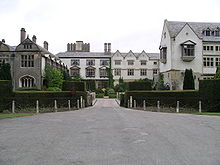Combe Abbey
| Cistercian Abbey of Combe | |
|---|---|
| location |
|
| Coordinates: | 52 ° 24 '38 " N , 1 ° 25' 14" W |
| Serial number according to Janauschek |
310 |
| Patronage | St. Mary |
| founding year | 1150 |
| Year of dissolution / annulment |
1539 |
| Mother monastery | Waverley Abbey |
| Primary Abbey | Citeaux monastery |
|
Daughter monasteries |
no |
Combe Abbey (Cumba, also Coombe, so the current Country Park and the hotel which is now furnished in the complex; probably by the British cwmm) is a former Cistercian monk abbey in Brinklow around 7 km east of Coventry in Warwickshire in England and 1 km north of the road A 427 to Lutterworth .
history
The monastery was founded in 1150 by Richard de Canville as a daughter of Waverley Abbey , the first Cistercian monastery in the British Isles, and thus belonged to the filiation of Cîteaux . A few years later, another Cistercian monastery, Stoneleigh Abbey, was built just seven and a half miles away . In the 13th century, the monastery, which was involved in sheep breeding and received larger equipment, achieved prosperity, but became particularly indebted under the abbot Richard (1328–1332) in the 14th century. In 1345 the abbot Geoffrey was murdered in the abbey. In 1451 the monastery was attacked. In 1470 King Edward IV stayed in the monastery. In 1535 the annual income was valued at £ 211.
In 1539 the monastery was handed over to the Crown by the last Abbot Kynner and his goods came from the Duchess of Somerset, who had initially received them, to John Dudley , the Earl of Warwick , as early as 1547 . In 1581 the buildings were converted into a mansion by Sir John Harington (or Harrington). In 1667 the house was extended to the west and from 1680 to 1690 a large west area was built by the architect William Winde. The outside area was designed by Lancelot 'Capability' Brown . From 1861 to 1864, William Eden Nesfield built a moat (“moat”) on the site of the former monastery church and built a new east wing around the remains of Romanesque buildings. Albert Joseph Moore painted the wall decorations for the new wing. These buildings were partially demolished in 1925 after the Craven family sold the complex in 1922 and then split it up into lots, and the new owner, Gray, had a more habitable building built.
After military use during the Second World War and subsequent use as a dormitory by the General Electric Company until 1964. In 1966 the Coombe Abbey Regional Park was opened, which has been called Coombe Country Park since 1970. The abbey buildings were used for historical banquets from 1971. After major renovation and reconstruction work, the hotel that still exists was opened in 1995.
Buildings and plant
The cross-shaped church was in the south of the complex, roughly at the site of the current moat, the north transept in the current east wing of the house, which forms a kind of bastion in the moat, the enclosure to the north of it. The west wing of the current building takes the place of the former Konversentrakt. The refectory was to the north, the chapter house to the east. Remnants of the cloister have been built into the west and north wings.
literature
- Anthony New: A guide to the Abbeys of England and Wales. Constable & Company, London 1985, ISBN 0-09-463520-X , pp. 121-122.
Web links
- Website of the Certosa di Firenze about the monastery with some photos
- Website of Cistercians Sheffield (English)
- updated Internet version of the book The Story of Coombe Abby by DL Motkin (1961) (English, with list of Abts)
- 'Houses of Cistercian monks: Abbey of Combe', A History of the County of Warwick: Vol. 2 (1908), pp. 73-75 (English)


